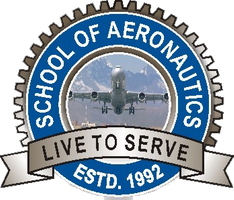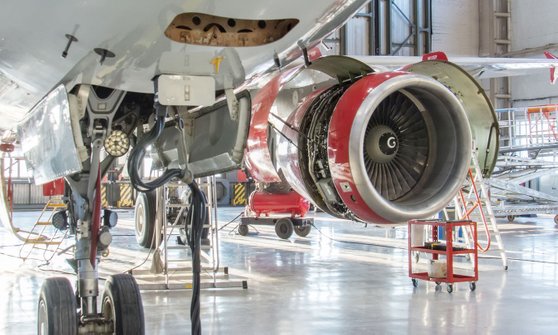LEADERS IN AVIATION INDUSTRY
30 YEARS OF GLORIOUS SERVICE TO AVIATION INDUSTRY, WE PROVIDE AERONAUTICAL ENGINEERING & AIRCRAFT MAINTENANCE ENGINEERING (AME) PROGRAMS SINCE 1992.
School of Aeronautics (Neemrana)
[Approved By AICTE / Director General of Civil Aviation, Affiliated to BTU & RTU]
SOA WAS AWARDED "TOP 10 AERONAUTICAL ENGINEERING COLLEGE IN INDIA"
BY CMAI, SUPPORTED BY AICTE, NSIC, DEPARTMENT OF MNRE, MSME
(GOVERNMENT OF INDIA)
B.Tech., AERONAUTICAL ENGINEERING PROGRAM
DETAILS FOR AERONAUTICAL ENGINEERING PROGRAM
Aeronautical Engineering is the emerging branch of engineering, with lots of developments and explorations taking place in flight vehicles.
Instead of a palette of colors, the aeronautical engineer has his own artist's palette of options. How he mixes these engineering options on his technological palette and applies them to his canvas (design) determines the performance of his airplane / flight vehicle. Aeronautical Engineers are the man behind these flying machines. To become an Aeronautical Engineer, one must do B.Tech (Aeronautical).
B.Tech., Aeronautical Engineering deals with researching new designs for aircraft, aircraft components, and engines, bringing design to software, i.e. making the researched design a reality, testing the design in related software, manufacturing and finally calculating its performance parameters in flight. Job profiles of Aeronautical Engineers include investigating the aerodynamical and structural forces acting on the machine, which has been designed by him. Aeronautical Engineers are also involved in analyzing the data of the flying machine, gathered through a series of test flights done on the aircraft before delivery to the aircraft operator.
These students are also involved in the planning, operations, and maintenance activities of the Aircraft. Aeronautical Engineers they not only work for Civil Aviation, but they are key role players in defense sector aviation jobs too. Aeronautical Engineering is the last branch of engineering, which is yet to be fully explored by the human race. The exploration efforts have already been started by humans of various countries. We invite you to join us for this exciting journey for the moon and beyond the sky, where sky is the steeping stone, but not the limit of the journey for Aeronautical Engineers.
Being a beginner in the Aeronautical Field, you will learn, how the aircraft flies, and which forces, acting on the aircraft will make it possible for the machine to be in the air, with such a huge weight.
Math and science are important subjects for the basic understanding of Aeronautical concepts. Its not that how you have done in those classes for Maths and Science, but how you you use that knowledge in your design. Being the designer of the Aircraft, Aeronautical Engineers will have to hone those skills of designing, that they will learn in the designing software classes. Aeronautical Engineers should be futuristic, for making their design a reality. The most beautiful thing about aeronautical engineers is that they can work on new things every day, which gives satisfaction where career advancement and financial growth is concerned.
DURATION FOR B.Tech., AERONAUTICAL ENGINEERING
It is a four-year degree program. It's spread over eight semesters. During this period students will have theoretical and practical classes along with internships at the end of each even semester.
EDUCATIONAL QUALIFICATION FOR ADMISSION INTO B.Tech., (AERONAUTICAL)
Minimum eligibility criteria for admission into B.Tech. Aeronautical is:
- Applicant must pass 10+2 with Physics, Chemistry, and Mathematics or equivalent. Students having any other optional subject in place of Chemistry are also eligible. E.g. Computer Science in place of chemistry along with Physics and Mathematics.
- 3 years Engineering Diploma in the relevant stream. (i.e. Diploma in Mechanical, Production & Industrial, Electronics & Communication, Electronics, Instrumentation & Control, Telecommunication Engineering and Aeronautical Engineering. Students with this qualification are eligible for lateral entry into the second year of the Aeronautical Engineering Program.
- B.Sc. with Physics, Chemistry, and Mathematics. Students with this qualification are eligible for lateral entry into second year of the Aeronautical Engineering Program.
- As per the AICTE norms, the candidate must have a minimum of 45% marks in 10+2 in PCM or equivalent or in any of the above qualification requirements.
SCOPE FOR AERONAUTICAL ENGINEERING
India is the third largest aviation market, with lots of scope to become the world’s largest aviation market in the near future. After Indian government’s make-in-India policy, lots of aircraft manufacturers have started outsourcing the designing and manufacturing of aircraft components in India. All these companies are looking for skilled Aeronautical Engineers to be employed in their companies.
Airbus and Boeing both have established their manufacturing units in India, these companies are also a big employer for Aeronautical Engineering passouts.
India’s aviation growth is visible by increasing passenger traffic, with lots of new airports coming up to cater to passengers’ traffic. In Delhi and Mumbai, at both metros, the Indian government is planning third and second airports, respectively. Passenger traffic has increased to the extent in Delhi that the government has already segregated the helicopter and nonscheduled operators flying from New Delhi Indira Gandhi International Airport. Helicopter flying is taking place from a separate India’s First Heliport at Rohini and nonscheduled operators or small aircraft operators are flying from a separate airport at Hindon. Due to this high growth in the Industry, more and more aircraft will be brought and manufactured, thereby increasing the jobs for Aeronautical Engineering passouts and already working experienced personnel.
Due to relaxation in taxes, the MRO industry is to boost up from 800 crores to 3000 crores in the next 3 years. Convergence between the defense sector and civil MROs will be established to create economics in scale. This will also generate huge jobs for Aeronautical Engineering graduates.
Aeronautical engineers are also employed in space sector jobs. According to Indian government latest announcement, Indian private sector is to be a co-traveler in the space sector journey. They will also provide level playing field for private companies in satellites, launchers, and space-based services. This will boost the job prospects for Aeronautical Engineering / Aerospace Engineering graduates.
Aeronautical Engineering graduates can apply for jobs in approximately 350 plus companies in India, to mention some of the companies and domain of aviation related companies are as follows:
- India Air Force, Army, Navy, Coast Guard, BSF, HAL, ISRO, DRDO, NAL, Taneja Aerospace, Mahendra Aerospace, Civil Aviation Department, DGCA, AAI, Scheduled Airlines, Non Scheduled Airlines, Private Airlines, Government Airlines, MRO, AMO, TECHNICAL PUBLICATIONS, DESIGNING COMPANIES AND MANUFACTURING COMPANIES.
AERONAUTICAL ENGINEERS JOB PROFILE
Aeronautical engineers design and test products for aircrafts, spacecrafts, satellites, and missiles. This involves tasks such as creating and testing prototypes, developing criteria for design methods, checking proposals, and coordinating teams from design to manufacturing. Aeronautical engineers spend most of their time in an office-based environment, using software design tools and simulation software for testing and training. This is a full-time job and often requires additional hours to work on larger projects, monitor progress, and ensure that the designs meet the necessary requirements. This job is well suited to people who communicate well, can manage their time effectively and work on multiple projects at once, who enjoy working as part of a team towards shared goals, and have good problem-solving skills.
DUTIES AND RESPONSIBILITIES OF AERONAUTICAL ENGINEERS
Aeronautical engineers carry out a range of duties depending on the organization they work for. Based on job profiles we analyzed, an aeronautical engineer’s responsibilities typically involve:
- Coordinating the Design and Testing of Aircraft Products
Aeronautical engineers coordinate and direct the design and manufacture of aircraft and aerospace products, making sure that they are tested properly and meet the necessary regulatory standards.
- Checking if Proposed Plans Meet Regulations
Regulations and safety standards are critical to aircraft manufacturing, so aeronautical engineers must determine if proposed projects will result in a safe operation as well as meet the goals outlined beforehand. This means checking that they meet engineering principles, the requirements of the customer, and environmental regulations.
- Developing Acceptance Criteria for Methods
Aeronautical engineers develop the criteria for design methods, completion dates, and quality standards that all projects work to adhere to for consistency and safety.
- Inspecting Damaged Products
Aeronautical engineers check malfunctioning or damaged products to identify where the fault lies and develop an appropriate solution. This requires applying engineering knowledge to the task and maintaining continuous education of the subject, in order to stay up to date with the latest technology and trends.
- Assessing Proposals
Aeronautical engineers assess proposals for different projects to determine if they are feasible, both on a technical level and financially.
SUBJECTS TO BE TAUGHT DURING 4 YRS DURATION IN B.Tech., AERONAUTICAL
Aeronautical Engineering is a 4 years degree program divided into 8 semesters. All the semester has theoretical and practical classes as per university norms. Every semester will have 40 % theory classes and 60 % practical classes. You, doing Aeronautical Engineering at School of Aeronautics, gives you notch over other college students in respect of PRACTICAL KNOWLEDGE. During these four years, you will undergo specially designed practical’s as per industry requirements. At SOA, along with course we are also providing you designing and analysis related software training too.
For the students of Aeronautical Engineering, first year is common with all branches of engineering, comprising of general engineering subjects, second year will have some core subjects and program related subjects. From third year onwards you will have only program related subjects.
HOW TO APPLY FOR B.TECH AERONAUTICAL ENGINEERING
Interested applicant for B.Tech. Aeronautical Engineering may apply for yearly entrance exam conducted by School of Aeronautics i.e SOACET. Applicant may visit our website www.soaneemrana.org/www.ameadmission.org or Click here to fill form directly.
B.TECH INFORMATION BROCHURE
Click here to download the brochure.
HIGHER QUALIFICATION (M.Tech.)
B.Tech. Aeronautical Engineering students, interested in pursuing higher studies can do so by joining post graduate courses, i.e. M.Tech. in Aeronautical Engineering. In India for admission into M.Tech., clearing a GATE examination is the eligibility criteria. One should clear GATE exam conducted by IIT. GATE score is the basis on which admission into M.Tech. program can be obtained. In some multinational companies, GATE score is a prerequisite for being considered for the various positions in their company. M.Tech. program is not available at SOA.
Some of the options / streams which are available in India, related to Aeronautical Engineering are:
- M.Tech. (Avionics)
- M.Tech. (Aerodynamics)
- M.Tech. (Propulsion)
- M.Tech. (Rocketry & Missiles)
- M.Tech. (Structures)
- M.Tech. (Avionics)
- M.Tech. (AME)
- M.Tech. (Aerospace)
After completion of post-graduation program, one can go for doctorate programs also.
Students interested to pursue courses outside country should write English language proficiency (e.g. a TOEFL/IELTS certificate, for schools in English speaking countries), or other language test. Admissions test results of GMAT/GRE results is also the requirements for certain courses.

